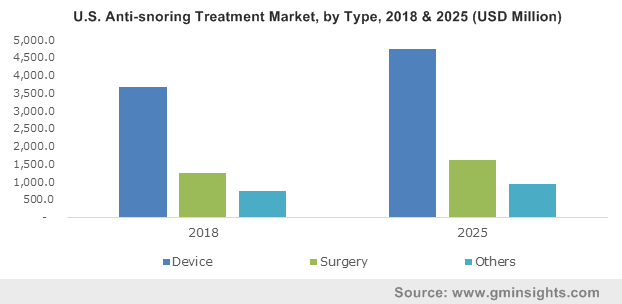Top three trends driving anti-snoring treatment market growth over 2019-2025
Publisher : Fractovia | Published Date : 2019-08-30Request Sample
The increasing prevalence of snoring among the overweight populace has been propelling anti-snoring treatment market share over the last few years. The disorder occurs when breathing is partially obstructed while sleeping. Considering the growing awareness about this disorder, many clinics have been imparting training programs to sleep medicine physicians to detect and diagnose sleep apnea with the help of advanced testing devices.
U.S. Anti-snoring Treatment Market, by Type, 2018 & 2025 (USD Million)

Pertaining to a sedentary lifestyle and unhealthy eating habits, issues like obesity, weight gain, and sleep deprivation have been increasing among the people. On these grounds, focusing on the increasing prevalence of snoring disorders among the obese, healthcare service providers have working continuously to introduce effective therapies. Rapid transformation in the healthcare sector and growing number of patients seeking medical care to treat snoring problems have had a remarkable influence on anti-snoring treatment market.
Following is a list of prominent trends that are slated to influence anti-snoring treatment industry outlook over the forecast timeframe:
Rising prevalence of a risk factor – obesity to accelerate industry outlook over 2019-2025
Increasing obesity is one of the prominent causes of surging prevalence of snoring disorders among people. Even studies have also shown that decrease in body weight can drastically reduce the chances of snoring. Loud snoring caused by obesity can often lead to breathing disorders such as sleep apnea further giving rise to other fatal issues like cardiovascular diseases. The adoption of unhealthy lifestyle habits such regular consumption of fast food and alcohol along with frequent smoking is expected to increase the number of obese people, indirectly augmenting industry trends.
According to World Health Organization (WHO), obesity cases worldwide have tripled as compared to the records of 1975. In 2016, over 650 million people were obese out of more than 1.9 billion overweight adults. Other than adults and elderly, it is even spreading among the children and teens. Reportedly, as per estimates of WHO, 41 million children under the age of 15 were obese in 2016.
These figures indicate the intensity of how obesity is engulfing a big part of the population. The increasing prevalence of obesity is anticipated to fuel the demand for anti-snoring treatments. In 2018, U.S. anti-snoring treatment market generated revenue of more than USD 5.6 billion, mainly due to increasing obesity among elderly population and growing sedentary lifestyle.
Availability of numerous anti-snoring remedies to drive industry trends
Earlier, there were very few treatment facilities available to diagnose snoring disorders. Today however, pertaining to continuous research and development activities, many treatment options are available for the patients. Most of them are based on the use of devices that are required to be worn while going to sleep, while others include surgical methods chosen based on obstruction cause.
Though surgical treatment carried via devices like Uvulopalatopharyngoplasty (UPPP) and Tonsillectomy can permanently fix snoring issues, they are not widely accepted among the patients with snoring disorders. Instead of surgical methods, people have been preferring non-surgical treatments pertaining to their efficacy.
CPAP devices has emerged as the most effective non-surgical treatment option for people suffering from sleep disorders like snoring and obstructive sleep apnea (OSA). These devices work by pushing warm, moist air down the throat in order to keep the airway wide enough for obstruction free breathing.
Reportedly, in 2018, CPAP devices market held the largest revenue share with a market value of USD 2.6 billion and the growth trends are slated to continue over the forecast timeframe. The high efficacy of CPAP devices which ensure comfort while sleeping will lead to high product adoption, and will further propel anti-Snoring Treatment market share.
Progressive technological advancements to impel market outlook
Increasing adoption of technology has been helping to produce advanced anti-snoring treatment devices which is expected to enhance anti-snoring treatment market growth over the forecast period. For instance, Apnea Sciences Corporation has launched a customized mandibular advancement device named as SnoreRx. Its superior patented design allows it to be fully adjustable with precise calibrations in 1 millimeter increments without any use of moving parts or metal hardware which makes it completely safe to use.
Additionally, many other devices have come into existence with the hybridization of technology trends. Hupnos sleeping mask is a combination of scuba and sleeping mask integrated with features like accelerometer. This high-tech mask with the smartphone application support detects any presence of the snoring sound.
On the detection of a snore, the mask determines the sleeping posture with the help of a built-in accelerometer and then it vibrates to get the user move to a different posture. If the change of sleeping position does not solve the problem, it also works like an expiratory positive airway pressure (EPAP) device, which helps open the airways and eliminate snoring. The launch of such products will positively influence global anti-snoring treatment industry outlook in the coming years.
Apart from the application of anti-snoring devices, introduction of non-invasive clinical treatments like laser snoring treatment and radiofrequency treatment that fix anatomical causes of snoring is also expected to prevail. Moreover, the growing awareness of anti-snoring treatments complemented by the expanding number of clinics having anti-snore treatment facilities will also support market growth over the forecast period. According to Global Market Insights, Inc., anti-snoring treatment market size will exceed USD 18 billion by 2025.